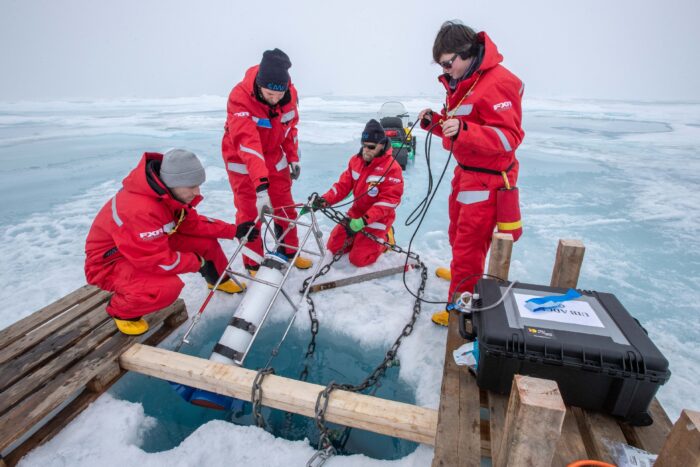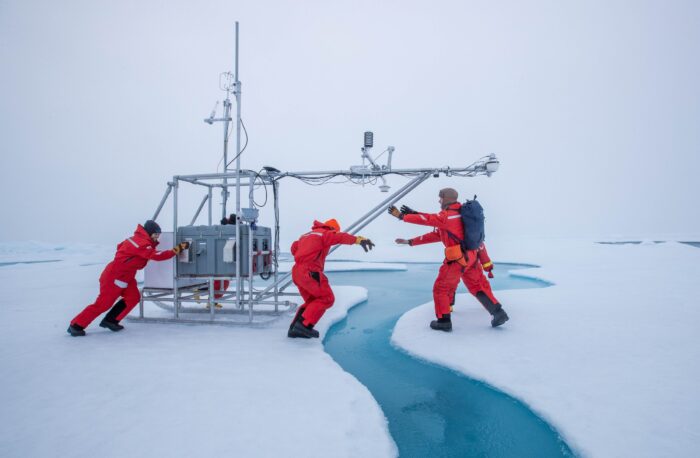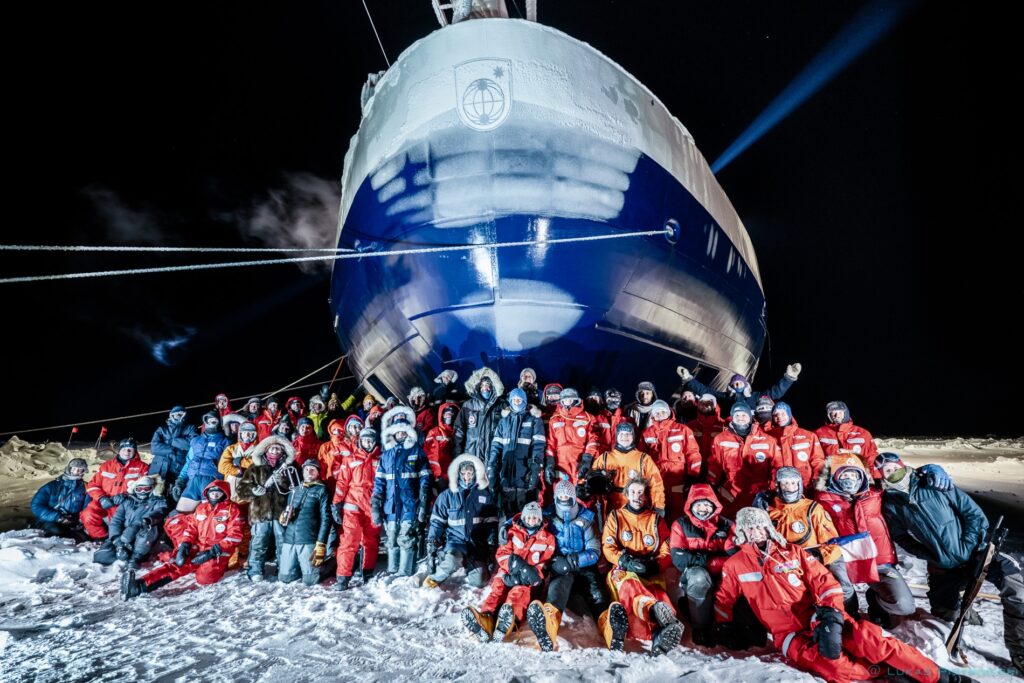Researchers have published three overview articles analyzing observations made during the one-year Multidisciplinary drifting Observatory for the Study of Arctic Climate (MOSAiC) expedition.
The €150m (US$170m) campaign saw experts from 20 nations explore the Arctic for an entire year, running from autumn 2019 to autumn 2020, aboard the German research icebreaker Polarstern.
The MOSAiC campaign captured hundreds of environmental parameters relating to the atmosphere, ocean, snow and sea ice. These results present the first complete picture of the climate processes in the central Arctic, which is warming more than twice as fast as the rest of the planet. They were published in the journal Elementa and highlight the importance of examining all components of the climate system together.
According to the researchers, diminishing sea ice is a symbol of ongoing global warming; in the Arctic, its extent has almost halved in summer since satellite records began in the 1980s. Surface air temperature has also been rising more than twice as fast as on the rest of the planet since the 1970s.
Less well studied but equally relevant are the thickness and other properties of the ice. What this means for the future Arctic and how these changes will affect the global climate was the impetus for the MOSAiC expedition.
To study the relevant processes for a full year required a special concept, in part because the Central Arctic Ocean is still ice-covered in winter and therefore difficult to access. During the expedition, the icebreaker froze to a large ice floe and drifted with the natural transpolar drift across the Arctic Ocean. “We found more dynamic and faster-drifting pack ice than expected,” said Dr Marcel Nicolaus, sea-ice physicist at the Alfred Wegener Institute, Helmholtz Centre for Polar and Marine Research (AWI) and co-leader of Team Ice in the MOSAiC project. “This not only challenged the teams on the ground in their daily work, but above all resulted in changed sea-ice properties and sea-ice thickness distributions.”
One of the reasons for the rapid drift is highlighted in the analysis of the atmospheric research team: “Near the surface there were particularly low temperatures and associated persistent strong winds in the winter months that pushed Polarstern faster than expected,” explained Dr Matthew Shupe, atmospheric scientist at CIRES at the University of Colorado and NOAA and co-leader of Team Atmosphere. “Large-scale atmospheric pressure and wind patterns in January to March led to a particularly strong polar vortex around the Arctic, in addition to a record ozone hole in the Arctic stratosphere.”
The oceanography team analyzed how atmosphere and sea ice changes are related to water temperature and salinity. Dr Céline Heuzé, physical oceanographer at the University of Gothenburg and co-leader of the MOSAiC Team Ocean, said, “We observed an increasing connection between the upper ocean and the deeper warm water layers in the Central Arctic Ocean, year round.”
Dr Benjamin Rabe, co-leader of the MOSAiC Team Ocean and physical oceanographer at the AWI, added, “We were able to fully map ocean eddies over a complete annual cycle during the expedition. Nearly simultaneous measurements from Polarstern, our camp set up next to it on the ice, and the distributed network up to 50km away from the ship provide the first assessment of small-scale events up to the regional scale.”

Autonomous sensors were mounted on, in and under the ice to provide coordinated measurements of properties like temperature, winds or currents in the atmosphere, in the sea ice and down to several hundred meters in the ocean below. Atmospheric winds push the ice and cause snow to drift. The researchers investigated in detail how the winds affect the sea ice, for example, by recording the tension in the ice and measuring cracks and the height of the rising ice ridges. These properties in turn influence where and how snow is deposited or swept away. Snow stands out for its extreme physical properties, as it insulates the sea ice against the atmosphere, reflects most of the sunlight and contains fresh water.
Nicolaus said, “We were able to show how short-term atmospheric events (storms in winter, warm spells in spring, meltwater fluxes in summer or rainfall in autumn) have large effects on the snow and sea-ice properties over the coming months. We found larger spatial variations in the snow cover than expected, due to atmospheric processes and the structure of the underlying sea ice. This extreme variability means that we have to consider the snow in much more detail for future model simulations and the interpretation of satellite observations. As we have also been able to make remote sensing measurements on the ice, these – combined with the detailed snow and ice observations – pave the way for new and improved sea-ice observations from upcoming satellite missions. In addition, this enables a better uncertainty assessment of existing satellite time series.”
Shupe added, “During MOSAiC, we observed more than 20 Arctic cyclones, or storms, of various scales that passed over our ice floe. We have described these events in unprecedented detail, characterizing the vertical wind structure and momentum transfer to the sea ice and ocean, leading to sea-ice movement and fracture. During these events, the impacts of warm air masses moving into the Central Arctic with their associated clouds caused significant shifts in all components of the surface energy balance, affecting the sea-ice temperature, growth and/or melt. Additionally, year-round information on the variability of atmospheric composition and aerosols provides new insights into the relative influences of long-range transport versus local processes, with important implications for climate-relevant cycles (e.g. the carbon cycle), clouds and the radiative balance.”
The three overview articles will serve as references for a vast array of future scientific work. “The physical observations are the basis for interpreting biogeochemical cycles and ecosystem processes, and for supporting coupled models that we use to learn even more about climate feedbacks and the global repercussions of Arctic change. These changes can affect weather and climate worldwide,” said Prof. Markus Rex, head of MOSAiC and atmospheric scientist at the AWI. “It is fascinating how accurately we can map individual processes and relate them to each other. I am pleased to see how several hundred MOSAiC participants have collaborated on these publications. International cooperation with expedition participants from so many countries continues productively in a highly coordinated manner, even though the expedition has been over for more than a year. In this way, we will be able to provide ever more important insights into climate change, which will provide a knowledge base for societal transformation toward a sustainable approach to planet Earth.”
MOSAiC was coordinated by the Alfred Wegener Institute, Helmholtz Centre for Polar and Marine Research (AWI). To make this unique project a success and to obtain the most valuable data possible, more than 80 institutes pooled their resources in a research consortium. The total cost of the expedition was mostly funded by the German Federal Ministry of Education and Research.




